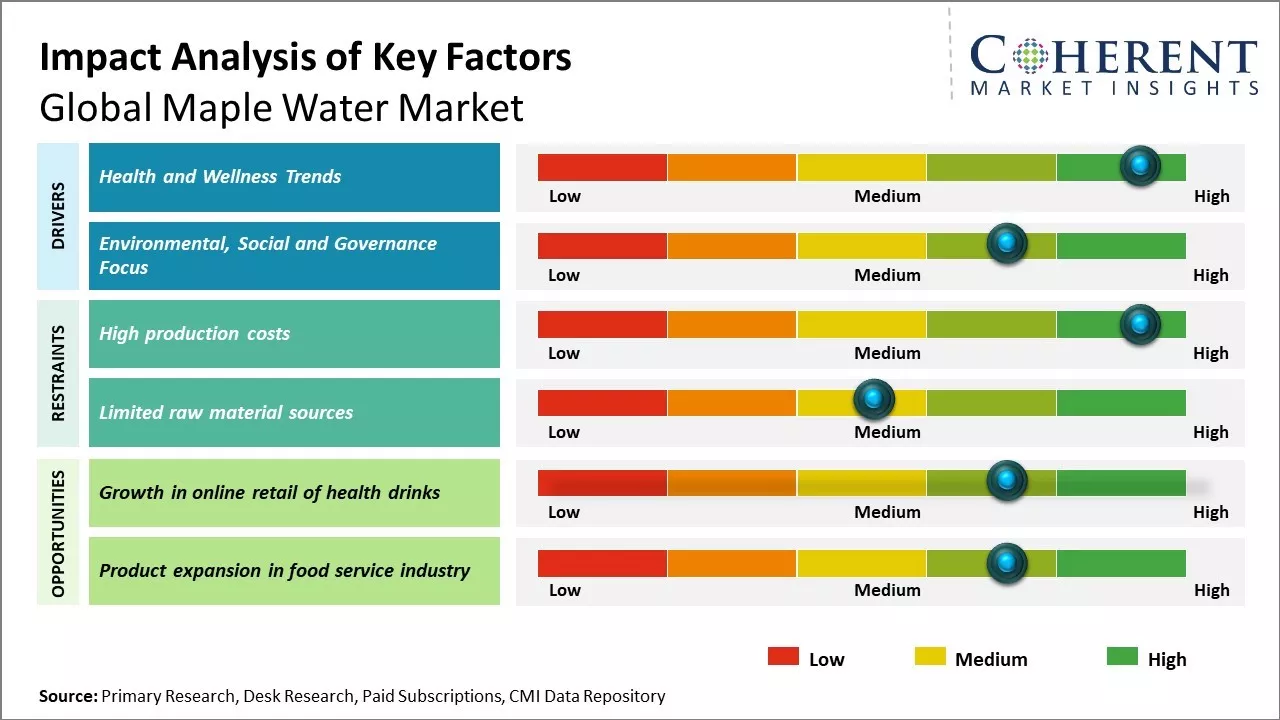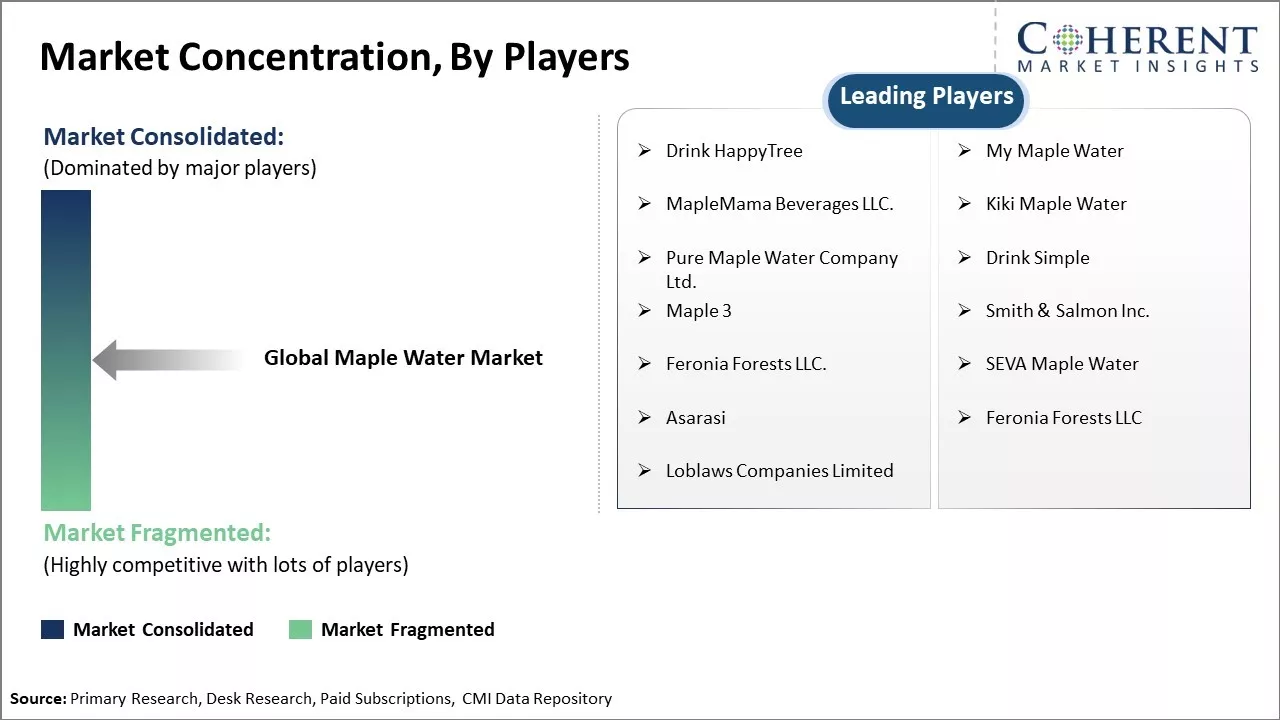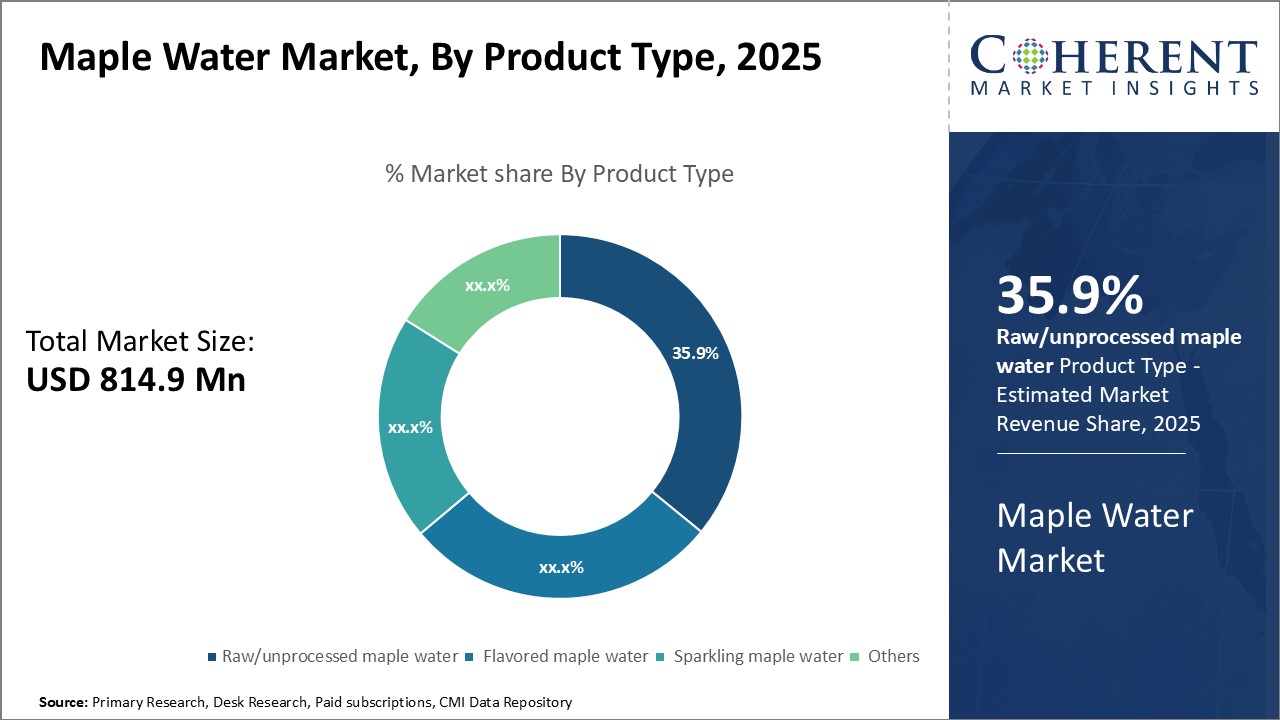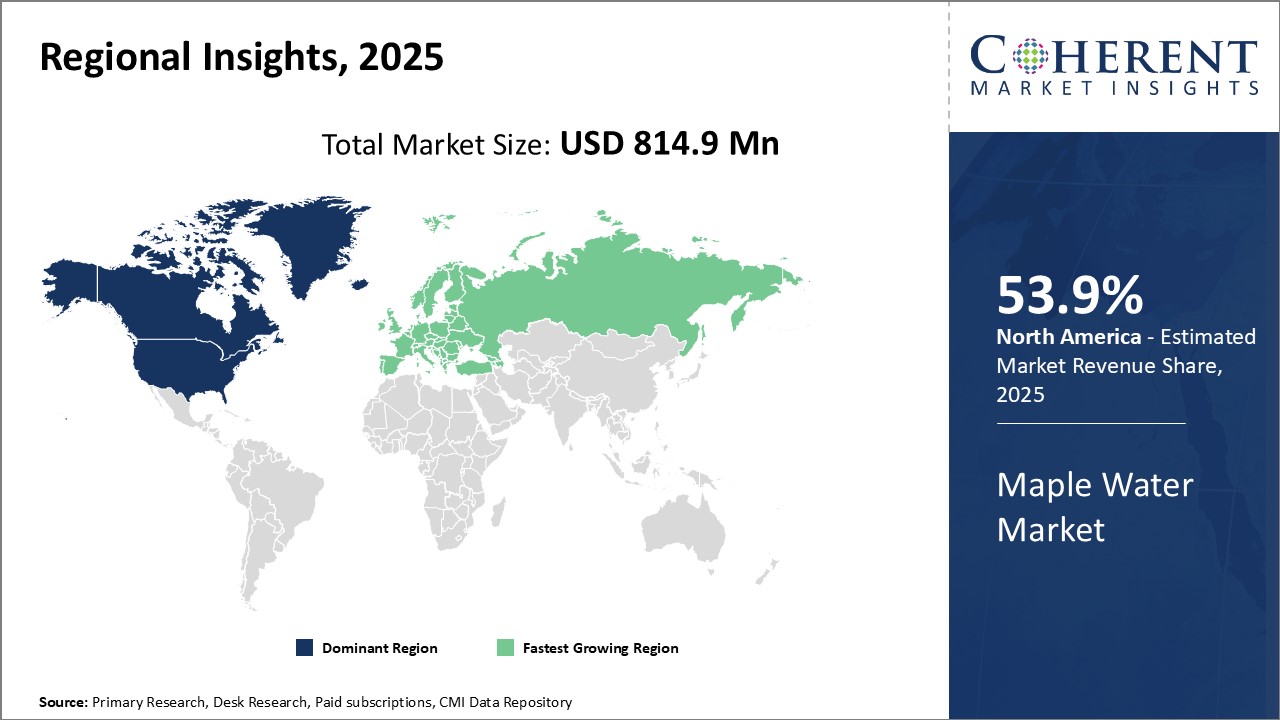Maple Water Market Size and Trends
The maple water market is estimated to be valued at USD 814.9 Mn in 2025 and is expected to reach USD 3,822.9 Mn by 2032, exhibiting a compound annual growth rate (CAGR) of 24.7% from 2025 to 2032.

Discover market dynamics shaping the industry: Download Free Sample
The global maple water market is experiencing positive growth trends. The rising health awareness among consumers regarding the consumption of healthy drinks with no added sugars is driving the demand for maple water. Furthermore, innovative product launches of maple water in various flavors and packaging sizes catering to diverse consumer taste preferences is also fueling the market growth. Several foodservice operators and restaurants have added maple water to their drinks menu to capitalize on the growing popularity of this naturally sweet tree sap, which is expected to continue supporting the sales of maple water in the coming years.
Health and Wellness Trends
The modern consumer is increasingly health-conscious and focused on wellness. Chronic diseases and health conditions such as diabetes, obesity, and heart disease are on the rise. People are actively looking to make changes in their lifestyle and diet in order to live a longer and healthier life. Against this backdrop, water has emerged as one of the most versatile ingredients that satisfies thirst as well as supports wellness goals of the health-minded consumer. However, consumers also want options that are low in calories and sugar. Maple water fits well here as it is low in calories and sugar compared to fruit juices and meets the demand for a clean, basic hydration. The benefits of maple water such as high mineral content including calcium, magnesium, and other antioxidants are being more widely recognized. Further, issues such as plastic pollution from bottled beverages have consumers looking at options that have lesser environmental impact. As producers provide more context about the natural and simple sourcing of maple water, it gains appeal from the health-conscious masses. The growing interest in herbal birch water shows that people are also exploring similar indigenous plant-based beverages. Maple water seems well-positioned to benefit from this trend as markets expand globally.
Market Concentration and Competitive Landscape

Get actionable strategies to beat competition: Download Free Sample
Environmental, Social and Governance Focus
Environmental, social and governance focus is significantly driving the growth of the global maple water market. Over the past few years, there has been rising health and wellness awareness among consumers regarding the ingredients in the beverages they consume. This growing focus on sustainability and healthier lifestyle choices is prompting many consumers to opt for natural beverages like maple water that have minimal processing and are low in calories. Maple water contains various nutrients like vitamins, minerals and antioxidants but does not have any artificial flavors, preservatives or added sugars which are present in most packaged fruit drinks and sodas.
The beverage industry is witnessing high demand for products that are environmentally sustainable and ethically sourced. Maple water producers are able to cater to this demand as tapping maple trees for its sap is considered an environmentally friendly practice with low carbon footprint. No trees need to be cut down to obtain maple water as the process is non-destructive involving tapping xylem layers from maple trees. Several maple producers are now obtaining certifications like Forest Stewardship Council (FSC) certification to highlight their sustainable sourcing process. The presence of such certifications gives traceability and assurance to health-conscious consumers.
Key Takeaways from Analyst:
The increasing health consciousness among consumers about adopting low-sugar beverages is a major driver for this market. Maple water contains no added sugar and is almost as sweet as coconut water, making it a suitable alternative to sugar-laden sodas and juices. The market is also benefitting from the rising popularity of plant-based beverages and the premiumization trend in the beverage industry. However, the availability of cheaper substitutes like coconut water and demand seasonality due to maple trees' tapping season could hamper the market's growth to some extent.
North America, particularly Canada, currently dominates the maple water market given that majority of the world's maple syrup production is concentrated in this region. However, increasing exports are helping producers gain foothold in other developed international markets like Western Europe and Japan.
The latent demand and growing health and wellness trend are expected to open up new lucrative opportunities for maple water producers in developing Asian economies over the forecast period. Despite facing initial challenges associated with distribution and production constraints, producers who focus on expanding their international footprint and introducing innovative packaging solutions will be better positioned to gain traction in the global marketplace.
Market Challenges: High production costs
High production costs is one of the major factors restraining the growth of the global maple water market. Maple water production is a labour intensive and time-consuming process which involves frequent manual tapping of maple trees to collect sap and further processing it into maple water. The entire process requires skilled labour force and large tracts of forest lands to cultivate maple trees, which increases the overall production costs significantly. Maple water production is highly dependent on the weather and seasonality. Maple trees need freeze-thaw cycles to collect maximum sap, which is only possible during early spring season for 4-6 weeks. This short seasonal window forces producers to undertake year-long maintenance of infrastructure, storage facilities and machinery to ensure smooth production during the season. All these factors associated with seasonal nature of production like maintaining excess infrastructure and equipment during off-season drives up the fixed costs for maple water producers.
Market Opportunities: Growth in online retail of health drinks
The global maple water market is poised to grow significantly in the coming years driven by rising health consciousness among consumers and growth in online retail sector. more and more people are now opting for healthy beverage options made from natural sources like maple water as substitutes for sugary drinks. Maple water contains no calories and is rich in various nutrients such as vitamins, minerals and antioxidants. Consumption of maple water is known to beneficial in weight management and reducing inflammation. Its clean label and nutritious profile appeal hugely to modern consumers who pay great attention to ingredients and wellness.

Discover high revenue pocket segments and roadmap to it: Download Free Sample
Insights by Product Type: Consumer Demand for Natural and Healthy Options Drives the Raw Maple Water Segment
Raw/unprocessed maple water is expected to contribute 35.9% share of the maple water market in 2025, due to strong consumer demand for natural and minimally processed beverages. Maple water consumers are increasingly health-conscious and seek out products with simple, clean ingredient lists. Raw maple water contains no added sugars, flavors, or preservatives—it is simply the sap from maple trees filtered and bottled. This purity and lack of artificial ingredients has become an important factor for many shoppers scouring beverage aisles.
The natural flavor profile of raw maple water also appeals to many trying to reduce their sugar intake. With a subtle sweetness and delicate maple essence, it can satisfy a craving for something sweet without relying on added sugars. As health awareness grows, some maple water drinkers see it as a refreshing alternative to sugary sodas and fruit drinks. Raw maple water markets itself as a "better-for-you" option due to its natural mineral content and lack of calories. This positioning has resonated strongly with wellness-focused consumers.
Raw maple water has also gained popularity among environmental and sustainability advocates. It utilizes components from maple trees that would otherwise go unused and diverts waste. The minimal processing keeps its carbon footprint low compared to options with added ingredients or packaging. For ethically-minded shoppers, raw maple water's simplicity and natural origin are a major selling point.
Insights by Distribution Channel: Hypermarket/Supermarket Dominate Due to Convenience and Product Availability
Among distribution channel, hypermarkets/supermarkets is expected to contribute 39.4% share in 20034, owing to unmatched convenience and product selection. As mainstream retail giants, supermarkets are visited regularly by most consumers for grocery needs. This high-traffic placement allows maple water constant visibility among shoppers on routine trips. It also benefits from prominent end-cap and aisle displays during key sales periods. Supermarkets' expansive inventories ensure maple water of all styles, price points, and pack sizes are readily available under one roof. Customers appreciative of one-stop shopping can evaluate options and find both national brands and specialized varieties. Staffed customer service desks and loyalty programs further enhance the shopping experience. The "fallback" option also appeals to those seeking maple water for a special occasion who may try a new brand on impulse.
These retail behemoths additionally leverage marketing muscle to raise product awareness. Advertising circulars, on-shelf signage, and in-aisle tastings spread awareness of new varieties. Social media promotions tie into customer purchase journeys. Partnerships with affiliated cafes and restaurants expose shoppers to maple water served outside the home. Hypermarket/supermarket positioning is further strengthened through promotions and discounts. Weekly deals reinforce the value proposition and drive repeat purchases from budget-conscious customers. Private label offerings satisfy more cost-sensitive shoppers while still providing the full shopping experience. This creates a positive feedback loop cementing maple water’s place on lists among regular grocery needs.
Regional Insights

Need a Different Region or Segment? Download Free Sample
North America has emerged as the dominant region in the global maple water market, driven primarily by the vast maple syrup producing industry in Canada. The region is expected to account for over 53.9% of the global maple syrup production and is home to several major maple syrup manufacturers and bottlers in 2025. Being the place of origin for this unique product, North America enjoys strong brand recognition and a well-established supply chain for maple water. Companies in the U.S. and Canada have highly optimized operations to efficiently handle processing, bottling, storage and distribution of maple water products. They leverage long-term relationships with local maple farms to secure steady supply of raw maple sap. Furthermore, strong consumer preference for North American brands and familiarity with maple flavors give regional players a competitive advantage over other regions. Several factors like established distribution channels, proximity to farms, and expertise in food production have allowed North America to maintain its stronghold over the maple water market.
Europe has witnessed the fastest growth in recent years and is emerging as an important new market. Countries like Poland, Ukraine, and Russia have seen the rapid proliferation of maple tree plantations driven by favorable climate and soil conditions to support maple growth. Being relatively new to the maple market, Eastern European nations do not yet have large scale commercial operations for maple syrup. However, maple water presents itself as a viable route to enter this high growth market and capitalize on the abundant sap supply. Lower production and labor costs compared to Western nations provide Eastern European companies an attractive value proposition. They have ramped up bottling capacity and focused on domestic as well as exports to global markets. Growing health consciousness and rising disposable incomes have boosted the demand for premium beverages like maple water among consumers in Eastern Europe. If favorable conditions persist, the region is well-positioned to significantly expand its share of the global maple water trade in the coming years.
Market Report Scope
Maple Water Market Report Coverage
| Report Coverage | Details | ||
|---|---|---|---|
| Base Year: | 2024 | Market Size in 2025: | USD 814.9 Mn |
| Historical Data for: | 2020 To 2024 | Forecast Period: | 2025 To 2032 |
| Forecast Period 2025 to 2032 CAGR: | 24.7% | 2032 Value Projection: | USD 3,822.9 Mn |
| Geographies covered: |
|
||
| Segments covered: |
|
||
| Companies covered: |
Drink HappyTree, My Maple Water, MapleMama Beverages LLC., Kiki Maple Water, Pure Maple Water Company Ltd., Drink Simple, Maple 3, Smith & Salmon Inc., Feronia Forests LLC., SEVA Maple Water, Asarasi, Feronia Forests LLC, and Loblaws Companies Limited |
||
| Growth Drivers: |
|
||
| Restraints & Challenges: |
|
||
Uncover macros and micros vetted on 75+ parameters: Get instant access to report
Maple Water Industry News
- In 2023, Royale Maple Corporation launched “Maple Water” Sports Drink
- In 2021, Maple 3, the pioneer in the production of maple water, introduced a new range of Ecocert, certified organic Sparkling Maple Waters in three delicious flavors
- In May 2021, KiKi Maple Water announced the expansion of its products into Loblaw's Brand locations, including Your Independent grocers, Valu-Mart, and City Mart
*Definition: The maple water market involves the production, processing, and commercialization of water extracted from maple trees during the annual sap run in early spring. Maple water is collected using tubing systems that draw sap up from the trees and collect it in holding tanks. It is then filtered and bottled for consumers as a naturally sweetened and unsweetened alternative beverage to regular water. Maple water has a subtle sweet taste and contains nutrients from the maple tree. It is marketed as a healthy, natural, and sustainable product.
Market Segmentation
- Product Type Insights (Revenue, USD Mn, 2020 - 2032)
- Raw/unprocessed maple water
- Flavored maple water
- Sparkling maple water
- Others
- Distribution Channel Insights (Revenue, USD Mn, 2020 - 2032)
- Hypermarket/Supermarket
- Convenience Store
- Online retail Store
- Others
- Regional Insights (Revenue, USD Mn, 2020 - 2032)
- North America
- U.S.
- Canada
- Latin America
- Brazil
- Argentina
- Mexico
- Rest of Latin America
- Europe
- Germany
- U.K.
- Spain
- France
- Italy
- Russia
- Rest of Europe
- Asia Pacific
- China
- India
- Japan
- Australia
- South Korea
- ASEAN
- Rest of Asia Pacific
- Middle East & Africa
- GCC Countries
- Israel
- Rest of Middle East & Africa
- North America
- Key Players Insights
- Drink HappyTree
- My Maple Water
- MapleMama Beverages LLC.
- Kiki Maple Water
- Pure Maple Water Company Ltd.
- Drink Simple
- Maple 3
- Smith & Salmon Inc.
- Feronia Forests LLC.
- SEVA Maple Water
- Asarasi
- Feronia Forests LLC
- Loblaws Companies Limited
Share
Share
About Author
Yash Doshi is a Senior Management Consultant. He has 12+ years of experience in conducting research and handling consulting projects across verticals in APAC, EMEA, and the Americas.
He brings strong acumen in helping chemical companies navigate complex challenges and identify growth opportunities. He has deep expertise across the chemicals value chain, including commodity, specialty and fine chemicals, plastics and polymers, and petrochemicals. Yash is a sought-after speaker at industry conferences and contributes to various publications on topics related commodity, specialty and fine chemicals, plastics and polymers, and petrochemicals.
Missing comfort of reading report in your local language? Find your preferred language :
Transform your Strategy with Exclusive Trending Reports :
Frequently Asked Questions
EXISTING CLIENTELE
Joining thousands of companies around the world committed to making the Excellent Business Solutions.
View All Our Clients
